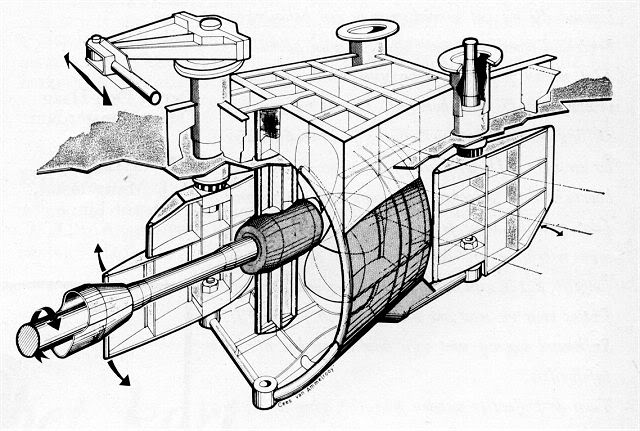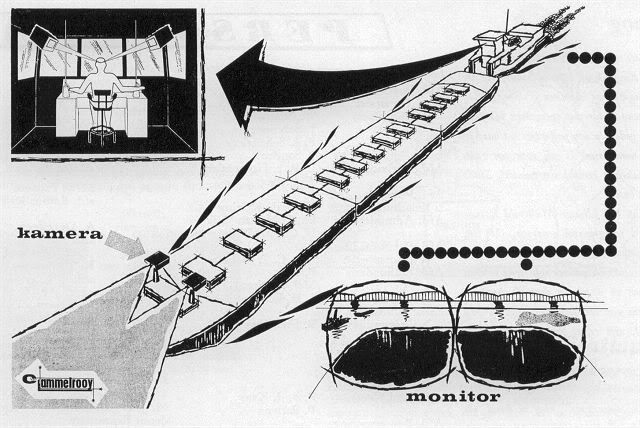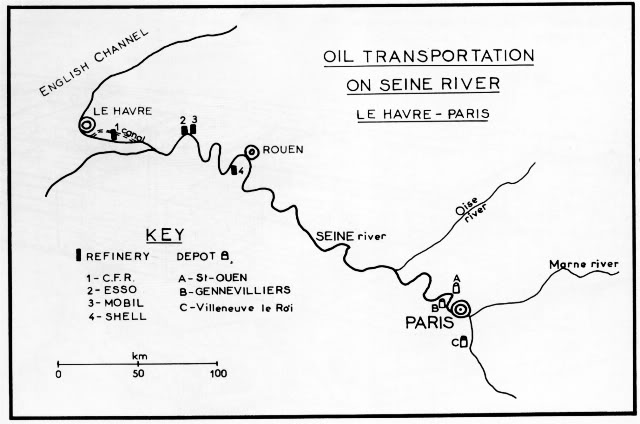Auke Visser´s Esso France Tanker's site | home
A new push tow on the Seine River
ESSO STANDARD S.A.F. has put in operation a push tow intended to deliver heavy products to the bulk plants and
terminals of the Paris area as well as to major customers.
This new unit is an addition to Esso Standard S.A.F.'s fleet, which included at this time two Seine River and 16 canal
self-propelled barges.
It is the most modern unit at present in operation on the Seine River. The name Esso Lutece has been given to the
pusher as a reference to the age-old tradition, in the field of inland waterway trade, of our capital, whose name in
ancient times was Lutece and whose motto is "Fluctuat nee mergitur" ("Sail But Do Not Sink").
As for the barges, they have more prosaically been named Esso L. 1, Esso L. 2 and Esso L. 3. The total length of
the convoy, made up of the pusher and three barges, is 160 meters because of the sizes of Seine River locks,
which have set limits to it. The pusher proper is 22 meters long and 9.50 meters wide, with 2.10 meters maximum
draft; each end barge is 45 meters long and 11,40 meters wide and, with a 3.50-meter draft, can carry approximate-
ly 1,370 tons of products.
The middle barge is longer with its 48 meters, but its other dimensions are the same as those of the end barges,
and it can receive a cargo of approximately 1,640 tons.
It must be noted that, for the time being, the authorized draft between the Lower Seine refineries and Paris is three
meters, which limits temporarily the carrying capacity of our push tow, pending the completion of the digging work
undertaken in some sections of the river.
The length of the pusher has been made as short as possible, and designing the equipment layout was a tough
job for the builders as, for an equal power, no Seine River pusher is shorter than our Esso lxjtece. Yet access to
and maintenance of the various equipment units are easy.
The engine room contains two Caterpillar propulsion engines, 760 horsepower each, one air compressor, two
electric power generators and two boilers.
These two automated boilers, which are Clayton's R.O. 175 type, permit maintaining the heavy products carried in
the barges at the necessary temperature for unloading to be made possible immediately on arrival without waiting
for the shore's heating.
Thus, by means of these boilers and of the pumps on the barges, unloading time can be considerably shortened.
Several hours are thus saved on unloading time as compared to our competitors' best push tow performances,
for as a rule, the Seine River units are neither equipped to unload their cargo nor to supply steam for cargo heating.
Aft is the Stork-Jaffa steering gear, all the component parts of which are also easily accessible, despite the exiguity
of the compartment, and which transmits the pilot's will to four flanking rudders and two main rudders.
Each of the two propulsion engines drives one 1.82-meter-diameter propeller revolving within a Kort-type nozzle,
The hull section above waterline features two levels.

The lower level contains the crew's living quarters. These feature a dining room, a lounge that can be used as a
cabin, one kitchen and three galleys.

A retractable wheelhouse permits the ESSO LUTECE to squeeze under the low clearance bridges spanning the
Seine River.
On the other side of a middle corridor, which separates this level in two sections, are the crew members' single cabins.
They are ten in number, two of which, somewhat roomier, are reserved for the master and his chief mate.
These cabins have been very elaborately outfitted, and special care has been devoted to soundproofing so as to provide
as quiet a rest as possible for the man not on duty.
The upper level essentially contains the wheel-house, which is retractable to allow passing under the bridges of the Seine
River; it features the latest improvements, which make navigation possible in the very best safety conditions.
Thus, the helmsman has at his command, in addition to the rudders, remote control and the instrument console to check
on the satisfactory operation of the whole, one radar, two TV receivers connected to two movable TV cameras mounted
on the leading barge, one very-high-frequency radiotelephone and one compass. An intercom, making it possible to com-
municate with the crew members wherever they may be, is also available to him.

The push tow is to be operated on a continuous service basis. The crew consists of two shifts of four operators and one
cook. Another four-man team is resting ashore.
The construction of this push tow was decided on in view of replacing the oldest Seine River self-propelled barges and
of covering transportation requirements which are unceasingly growing, and at the same time of lowering the cost to the
ton of product transported.
It is hoped that the transportation cost for products carried by the Esso Lutece will be about 35 percent lower than that of
ESSAF, our best Seine River self-propelled barge.
